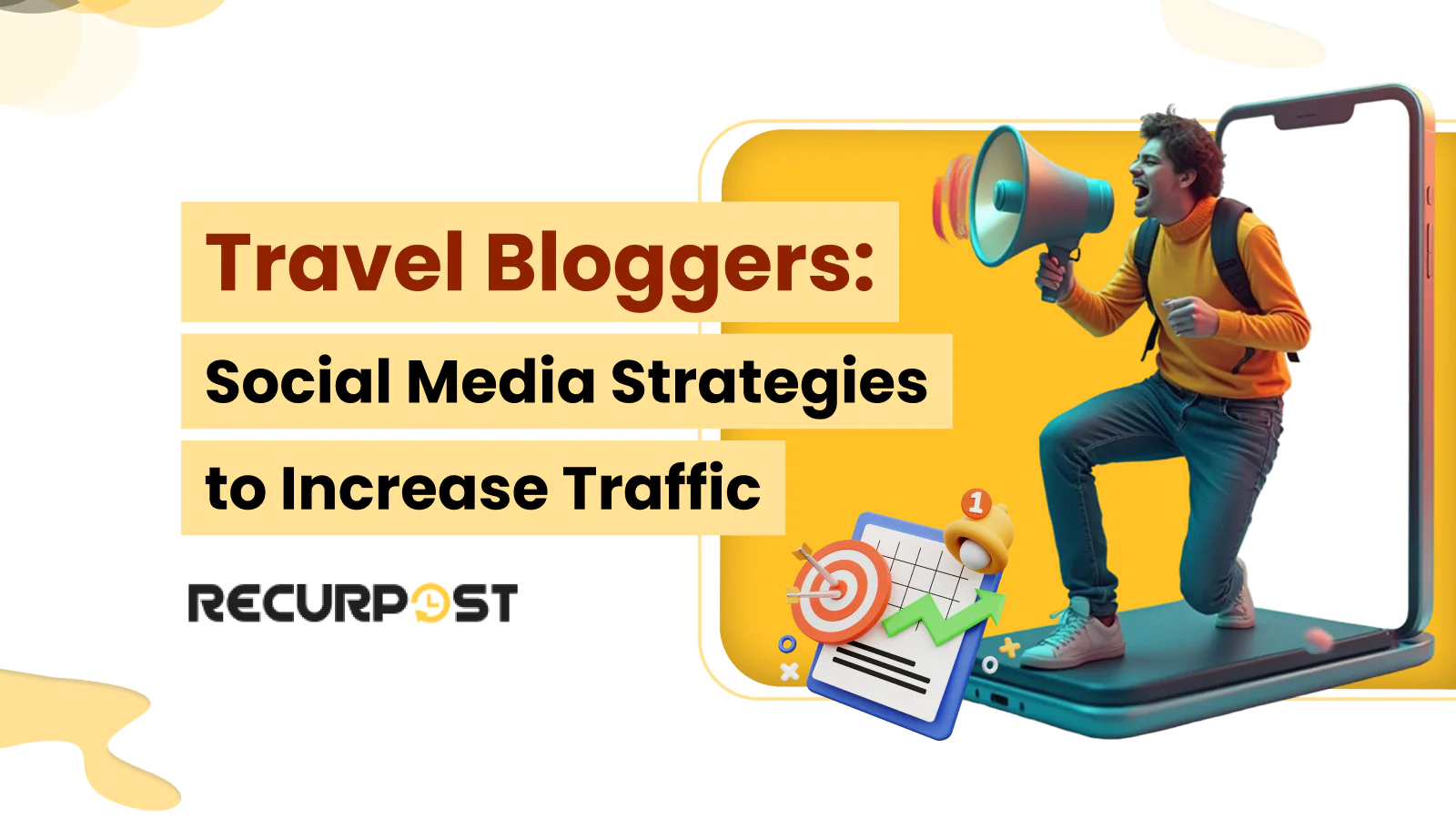Your Travel Blog Needs Social Media to Thrive in 2025
If you’re running a travel blog without an active social media presence in 2025, you’re practically invisible. Your articles, whether about Tuscany’s hidden gems or backpacking Southeast Asia, need social media to gain readers, build your audience, and attract brand deals.
Short-form videos now drive 73% of travel inspiration decisions (Statista), making TikTok and Instagram Reels essential tools for travel bloggers. Successful creators repackage their existing blog posts into Reels, Pins, or TikTok to reach more eyes and boost engagement.
This roadmap offers practical tips, real-life examples from top travel bloggers, and actionable ways to build a profitable brand through social media.
What You’ll Get:
- Social media tips for each major platform
- Real content examples proven to drive engagement
- Clear ways to monetize your blog and attract brand partnerships
Attract travelers to explore your travel blog.
Choosing the Right Social Platforms For a Travel Blog (And How to Win on Each)
Most travel bloggers get it wrong from day one: they try to be everywhere at once. Many creators spread themselves so thin across seven platforms that they’re mediocre on all of them instead of excellent on two or three.
Focus on a few platforms and dominate those spaces completely.
1. Instagram: Still the Crown Jewel for Travel Blog
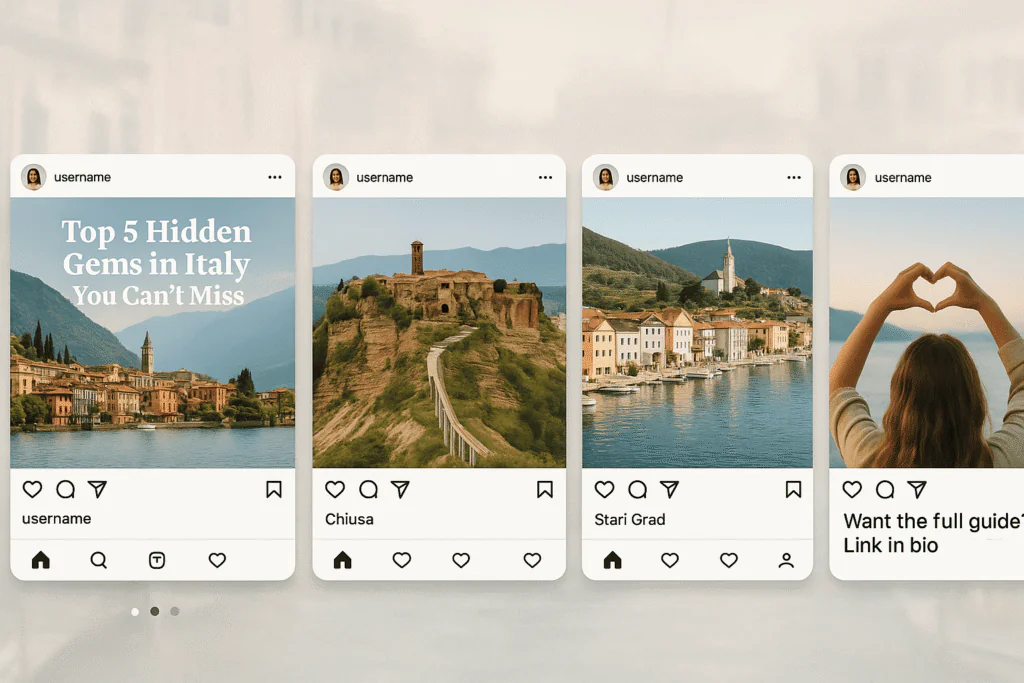
Instagram remains the holy grail for travel bloggers, but the platform you knew in 2020 is gone forever. Reels rule the kingdom now, and if you’re still banking on feed posts to carry your growth, you’re in for a rude awakening.
The New Instagram Game Plan for Travel Blog
A successful Instagram strategy has three pillars: stunning visuals, authentic storytelling, and consistent engagement. The twist: it’s not about perfection anymore. The most successful travel accounts show real moments, travel fails, and behind-the-scenes content alongside magazine-worthy shots.
Carousel posts are great for boosting engagement. They keep people swiping, which Instagram’s algorithm loves. Try the “Before/After” format: slide one shows the Instagram-perfect version of a location, and slide two reveals what it looks like when you arrive.
Your captions need to do the heavy lifting now. Think of them as mini-travel blog posts that tell a complete story. The accounts growing fastest use captions that make people feel like they’re traveling alongside you, not just observing from the sidelines.
Reels That Transfer Traffic To Travel Blog
Many travel bloggers focus on making Reels pretty instead of useful. Reels that consistently hit 100K+ views answer specific questions: “Is Bali worth the hype?” or “What I wish I knew before visiting Iceland.“
Hook viewers in the first three seconds with a bold statement or intriguing question. Then deliver genuine value, whether that’s money-saving tips, hidden gems, or honest reviews. The algorithm rewards Reels that keep people watching until the end, so structure yours with a payoff that’s worth waiting for.
2. TikTok: Where Travel Blog Goes Viral
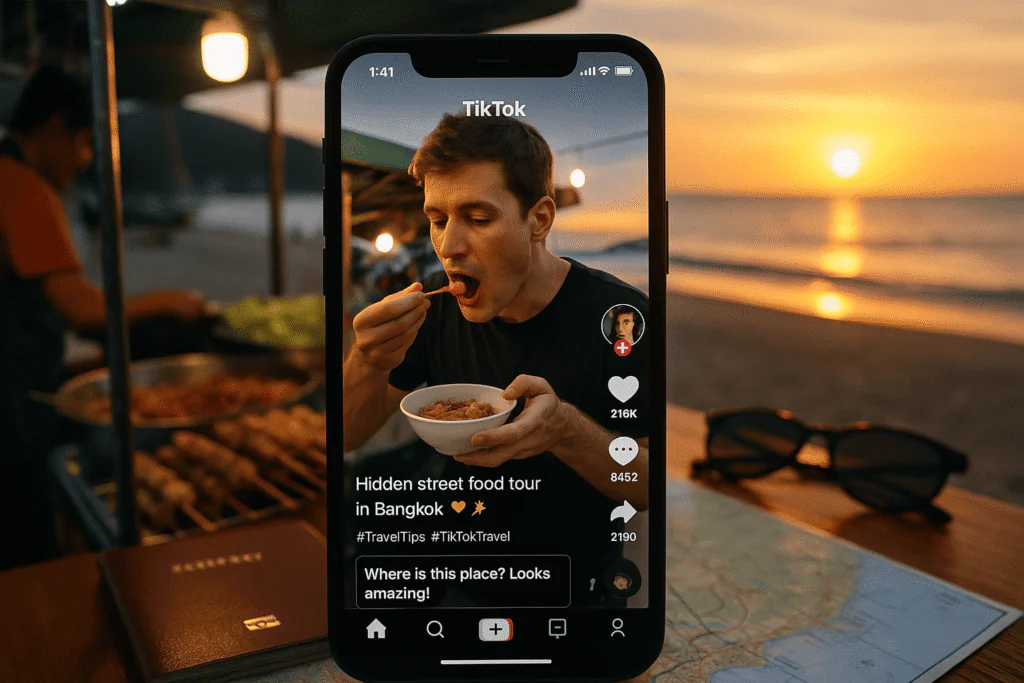
TikTok isn’t just for Gen Z anymore; it’s become a legitimate travel research platform. According to Science Direct, over 60% of users now discover travel destinations through TikTok, making it essential for any serious travel content creator.
Mastering TikTok’s Unique Culture
TikTok rewards authenticity over polish. Your shaky iPhone footage of a street food market will often outperform your perfectly stabilized drone shots. The platform thrives on spontaneous moments and genuine reactions.
Trending sounds are your best friend, but don’t just jump on any trend. Look for sounds that align with travel content, whether it’s a trending song perfect for showcasing a destination montage or a popular audio clip you can adapt for travel tips.
The comment section is where TikTok magic happens. Respond to every comment in your first hour after posting, and use comments as inspiration for follow-up videos. Someone asks about your hotel in Lisbon. That’s your next video right there.
Travel Hooks That Stop the Scroll
Here are five proven hook formulas that work specifically for travel content:
- The Cost Breakdown: “I spent 3 weeks in Thailand for $800, here’s exactly how…”
- The Mistake Warning: “Don’t make the same mistake I did in Paris…”
- The Hidden Gem: “This place doesn’t even show up on Google Maps…”
- The Reality Check: “Instagram vs. Reality in Santorini…”
- The Local Secret: “A local taxi driver told me about this spot…”
3. Pinterest: Your Traffic-Driving Powerhouse for Travel Blog
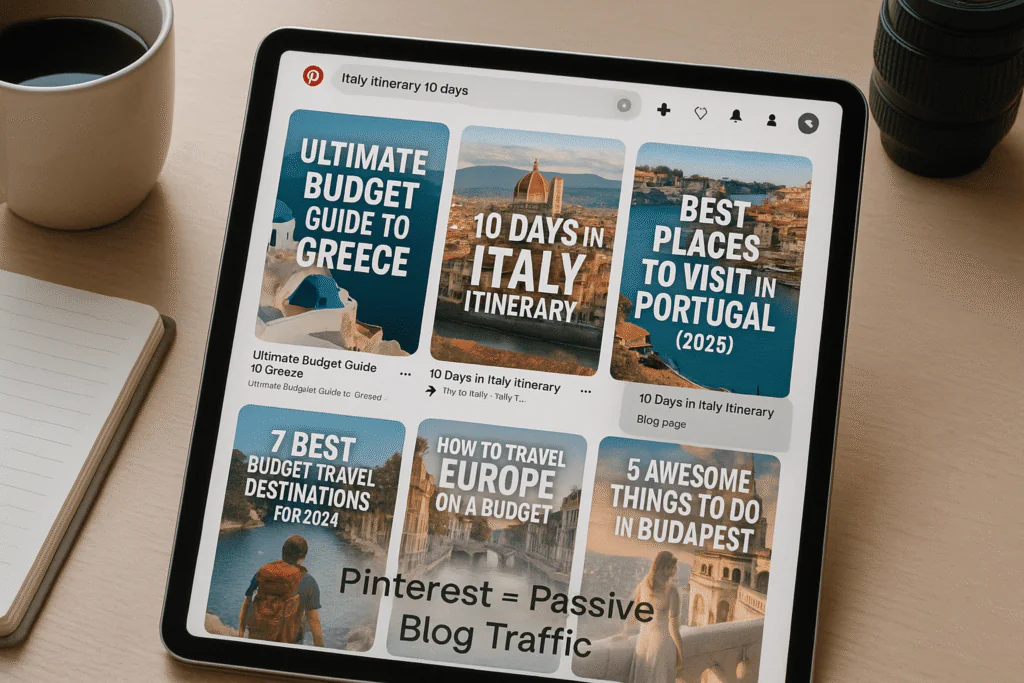
While most creators are focused on video content, Pinterest quietly drives more travel blog traffic than any platform other than Google. It’s the ultimate long-term strategy for travel bloggers who want sustainable, passive traffic growth.
Pinterest SEO That Works For Travel Pin
Pinterest functions more like a search engine than a social platform. Your pin descriptions need to include the keywords people search for. Think “budget travel tips Europe” instead of “wanderlust vibes.“
Vertical pins still dominate, but make sure your images tell a clear story at thumbnail size. Text overlay is crucial; users should understand your pitch’s value proposition within two seconds of seeing it.
Seasonal planning is everything on Pinterest. Start pinning your summer Europe content in February, not June. The platform’s users plan trips for months, so timing your content for future travel seasons is essential.
Must Know– Pinterest Pin Dimensions For Effective Content
Driving traffic to your best travel blog
Every pin should have a clear purpose to drive traffic to your blog. Create pins for individual travel blog posts, but also design pins that capture broader topics. A single travel blog post about “10 Days in Japan” could generate five different pins: budget breakdown, itinerary highlights, food guide, cultural tips, and packing list.
Rich Pins are non-negotiable. They pull additional information directly from your blog, making your pins more informative and trustworthy. The setup takes 30 minutes, but it’ll significantly boost your click-through rates.
4. YouTube Shorts: Balancing Long and Short-Form Content
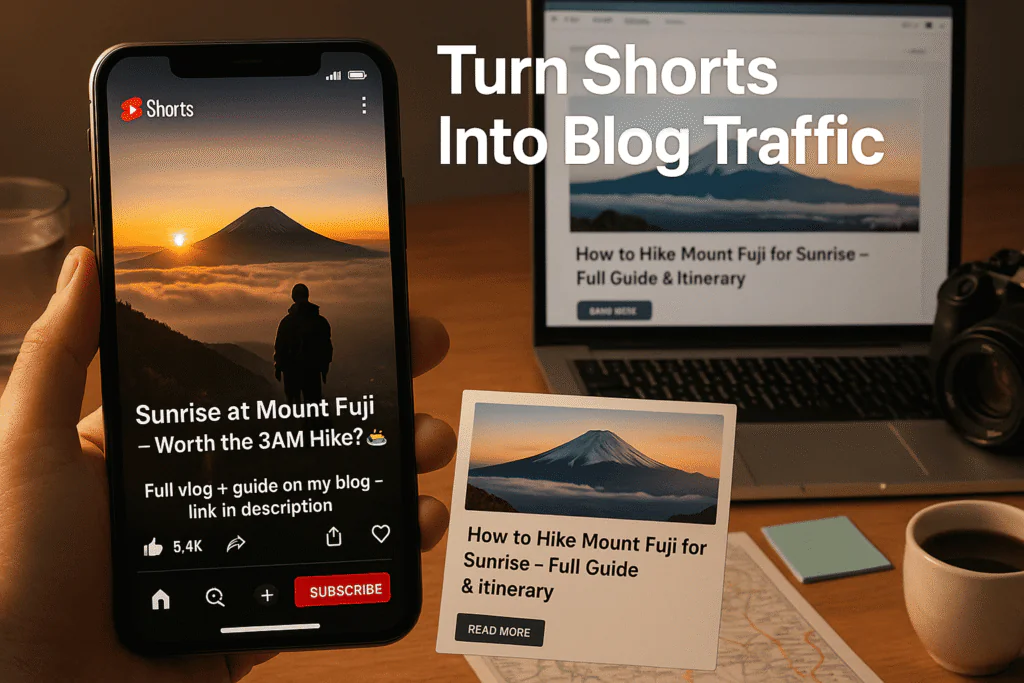
YouTube’s trying hard to compete with TikTok, and they’re rewarding creators who jump on the Shorts bandwagon. But here’s where travel bloggers have a unique advantage: you can use Shorts to drive viewers to your longer-form travel vlogs.
The YouTube Shorts Strategy For Travel Shorts
Think of Shorts as trailers for your main content. That 30-second clip of you trying street food in Bangkok? It should end with “full food tour on my channel” to drive viewers to your longer videos.
YouTube Shorts work best when they’re genuinely helpful or entertaining. Quick tips, stunning time-lapses, or “day and night in my life” snippets perform consistently well. The key is making content that feels native to the Shorts format, not like chopped-up pieces of longer videos.
Platform-by-Platform Algorithm Decoder (2025 Edition)
Understanding what each platform’s algorithm prioritizes can make or break your content strategy and ultimately determine whether your travel blog gets the traffic it deserves. Here’s what’s working right now:
| Platform | Primary Ranking Factor | Content Format Priority | Best Posting Time | Engagement Sweet Spot |
| Engagement rate within the first hour | Reels > Carousels > Stories | 6-9 AM, 7-9 PM local time | 30+ comments, high saves | |
| TikTok | Completion rate + shares | Native vertical video | 6-10 AM, 7-9 PM EST | High completion rate, comments |
| Click-through rate + saves | Vertical images with text | 8-11 PM, weekends | Saves and clicks on the blog | |
| YouTube | Watch time + engagement | Shorts + long-form balance | 2-4 PM, 8-10 PM | High retention, comments |
The trick isn’t gaming these algorithms, it’s creating content that naturally aligns with what they reward. Make content that people want to engage with, and the algorithm will take care of the rest.
Creating a Scroll-Stopping Travel Blog Content Strategy
We’ve seen travel bloggers with stunning content stuck at just 5K followers, not because their visuals weren’t great, but because they posted whenever they felt like it, with no clear strategy.
Aimless posting doesn’t build momentum, and it doesn’t drive traffic to your travel blog.
Consistency, intention, and platform-specific planning are what turn followers into readers and readers into loyal fans.
Successful travel content creators operate more like media companies than casual bloggers. They plan content themes, maintain consistent posting schedules, and create content that serves their audience’s specific needs.
The 5-Part Content Mix Formula For Travel Blogging
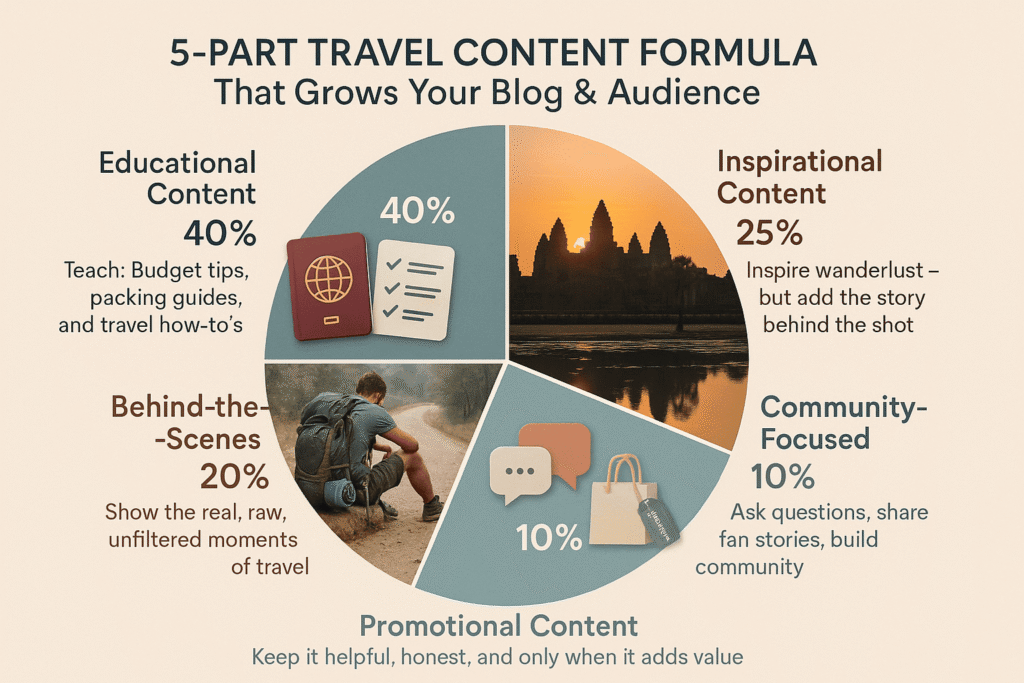
This formula has transformed dozens of travel accounts we’ve worked with. Instead of posting whatever feels right in the moment, you’ll have a proven framework that keeps your audience engaged and constantly growing.
Educational Content (40%)
This is your bread and butter, content that teaches people something useful about travel. Think budget breakdowns, packing tutorials, cultural etiquette guides, or “how-to” videos for specific destinations.
Educational content performs consistently well across all platforms because people actively seek it out. Your “Complete Guide to Solo Female Travel in Morocco” will generate traffic and engagement for months, even years after you post it.
Inspirational Content (25%)
These are your stunning visuals and aspirational posts that make people want to book their next trip immediately. Sunrise shots from Angkor Wat, northern lights dancing over Iceland, or that perfect beach in the Maldives.
But here’s the key: even inspirational content needs context. Don’t just post a pretty picture; tell the story behind it. What time did you wake up for that sunrise? How many attempts did it take to capture that shot?
Behind-the-Scenes Content (20%)
People crave authenticity, especially in travel content. Show the not-so-glamorous moments: missed flights, food poisoning, getting lost in a foreign city. These posts often generate the highest engagement because they’re relatable and real.
Behind-the-scenes content also humanizes your brand. Your audience needs to see you as a real person, not just a perfectly curated travel machine.
Community-Focused Content (10%)
Ask questions, run polls, share user-generated content, or highlight your followers’ travel experiences. This content builds community and encourages engagement, which every algorithm loves.
The best community content makes your audience feel heard and valued. Feature their travel photos, answer their questions in dedicated posts, or create content based on their suggestions.
Promotional Content (5%)
Yes, only 5%. This includes sponsored posts, affiliate promotions, or content that directly sells your products or services. The reason this percentage is so low? Building trust and providing value should always come before making money.
When you do create promotional content, make it genuinely helpful. Your sponsored hotel review should be as honest and detailed as your organic content. Your affiliate product recommendations should be things you use and trust.
Must Learn– Affective content creation strategy for 2025
Visual Aesthetics & Captions That Work For Travel Blog
Your visual style is your brand’s signature; it’s how people recognize your content in a crowded feed.
But aesthetic consistency doesn’t mean using the same filter on every photo. It means developing a cohesive visual language that reflects your unique travel philosophy. Balanced, strategic visual planning not only elevates your content but also significantly boosts the credibility and appeal of your travel blog.
Developing Your Visual Voice
Some travel accounts lean heavily into bright, saturated colors that scream adventure and excitement. Others prefer moody, cinematic tones that suggest mystery and depth. Neither approach is wrong, but you need to pick a lane and stay in it.
Your visual style should reflect your target audience and the type of travel experiences you promote. Luxury travel content typically uses clean, minimal aesthetics with plenty of white space. Budget backpacking content often embraces grittier, more authentic visuals.
Caption Strategies That Drive Engagement
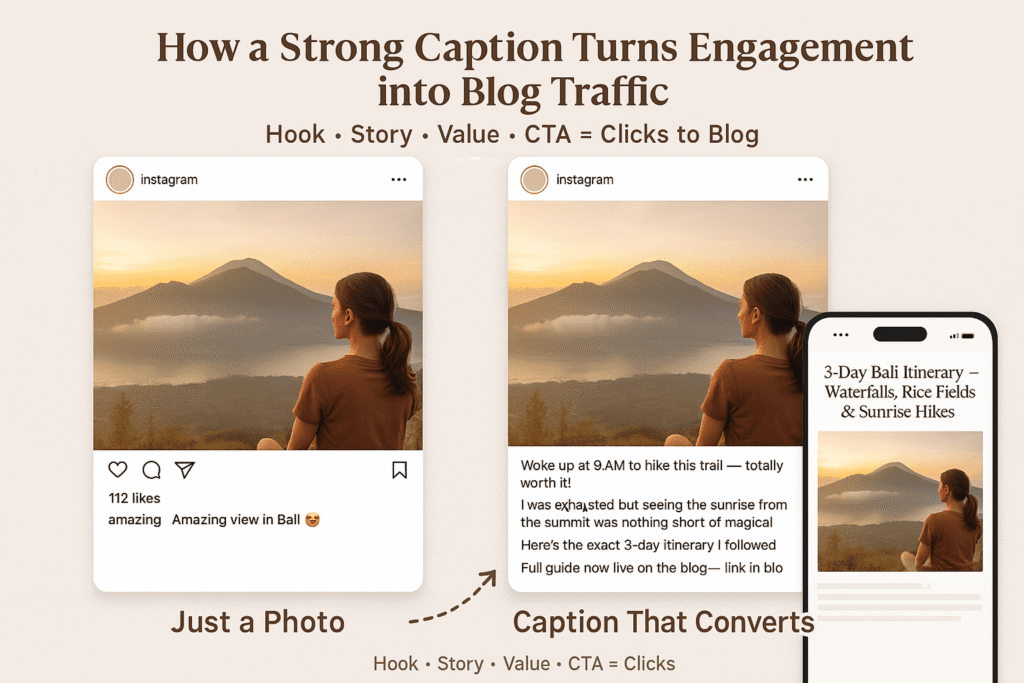
Your captions are where the real magic happens. They transform a simple photo into a conversation starter, a teaching moment, or an emotional connection with your audience.
The most engaging travel captions follow a simple structure: hook, story, value, and call-to-action. Start with something that grabs attention, tell a brief story about the moment or location, provide useful information, then ask a question or encourage interaction.
Long-form captions consistently outperform short ones in travel content. Don’t be afraid to write 200-300 words if you have something valuable to share. Your audience follows you for travel insights, not just pretty pictures.
Must Use- Our AI-generated caption generator for your travel content
AI Social Media Posts Generator: Create Content with RecurPost
Create engaging social media posts with our AI-powered generator. Save time and boost your content strategy with automated posts for all platforms in seconds.
Visual Hook Frameworks for Reels & TikTok
Short-form video content lives or dies in the first three seconds. Your opening hook determines whether someone keeps watching or scrolls to the next video. Here are five proven frameworks specifically for travel content:
The Contradiction Hook
Start with something that challenges common assumptions about a destination. “Everyone says Paris is expensive, but I spent 5 days there for under $300…” This immediately captures attention because it contradicts what people expect to hear.
The Mistake Hook
People are naturally curious about failures and mishaps. “I made a huge mistake booking this ‘luxury’ resort in Bali…” hooks viewers because they want to know what went wrong and how to avoid the same mistake.
The Secret Hook
Promise insider knowledge that most travelers don’t know. “This hidden beach in Thailand has no tourists because most people can’t find it…” creates immediate curiosity and positions you as an expert with exclusive access.
The Transformation Hook
Show dramatic before-and-after scenarios. “I was terrified of solo travel until this happened in Nepal…” appeals to people’s desire for personal growth and transformation through travel.
The Numbers Hook
Specific numbers grab attention because they promise concrete, actionable information. “I visited 15 countries for $3,000, here’s exactly how…” works because it provides a clear, measurable outcome.
Must Learn– How to create a visually appealing YouTube short
Performance Metrics That Matter
Track these metrics to understand which hooks work best for your audience:
- 3-second retention rate: The percentage of viewers who watch past the first three seconds
- Average watch time: How long do people stay engaged with your video
- Completion rate: The percentage who watch your entire video
- Save rate: How often people save your content for later
- Share rate: How frequently your content gets shared with others
Time-Saving Tools & Content Planning Workflow
Content creation can easily consume 40+ hours per week if you don’t have systems in place. Top travel bloggers approach content creation as a business process, batching similar tasks, automating repetitive work, and leveraging tools that boost their efficiency.
Content Calendar That Works
Forget those generic content calendars that tell you to “post 3 times per week.” Your content calendar needs to account for your travel schedule, seasonal trends, and platform-specific requirements.
The Travel Blogger’s Content Calendar Structure
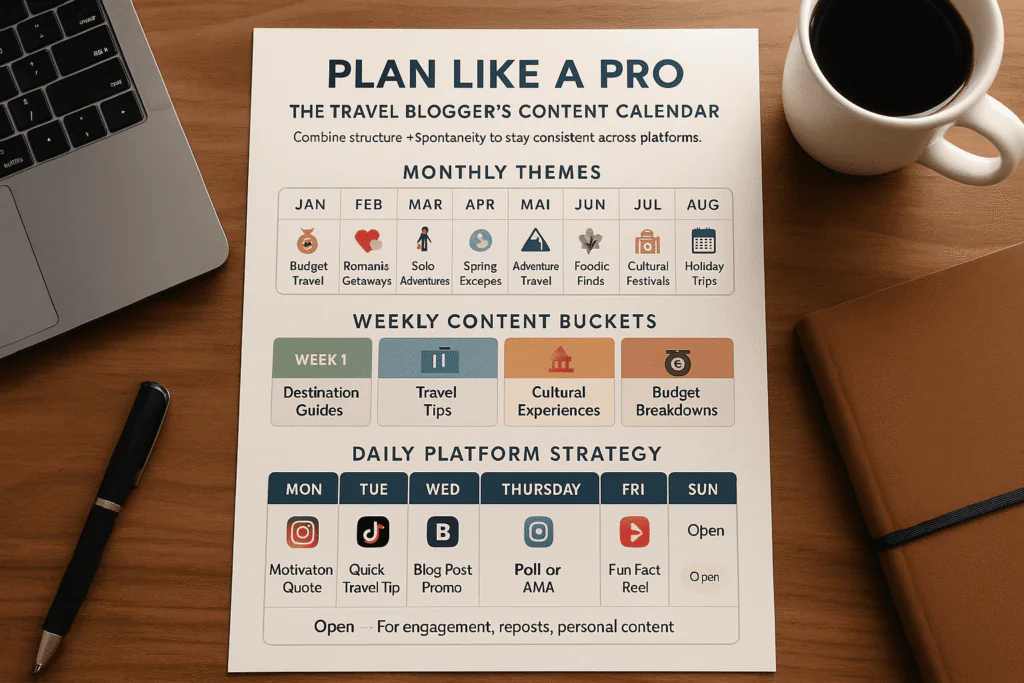
Monthly Themes
Assign each month a broad travel theme. January might focus on budget travel, February on romantic destinations, and March on solo travel adventures. This gives your content direction and makes planning easier.
Weekly Content Buckets
Within each month, rotate weekly themes. Week one covers destination guides, week two focuses on travel tips, week three highlights cultural experiences, and week four showcases budget breakdowns.
Daily Platform Strategy
Map specific content types to each day of the week across platforms. Monday motivational posts on Instagram, Tuesday TikTok tips, Wednesday travel blog promotion, Thursday community engagement, Friday fun travel facts.
Planning Around Your Travel Schedule
The biggest mistake travel bloggers make is trying to create fresh content while actively traveling. You should be documenting experiences during trips, and not stressed about posting schedules.
Plan content creation sprints between trips. Spend 2-3 dedicated days creating a month’s worth of content, then focus on documentation and real-time engagement while traveling.
Tool Comparison: Free vs Paid Options
| Function | Free Option | Paid Option | Winner For | Monthly Cost |
| Design | Canva Free | Canva Pro | Beginners: Free, Pros: Paid | $0 / $15 |
| Scheduling | Later Free | Buffer | Volume posting: Buffer | $0 / $99 |
| Analytics | Native platform tools | Sprout Social | Deep analysis: Paid | $0 / $199 |
| Video Editing | CapCut | Adobe Premiere | Quick edits: Free, Pro: Paid | $0 / $23 |
| Stock Photos | Unsplash | Shutterstock | Quality needs: Paid | $0 / $29 |
| Content Recycling | RecurPost Free | RecurPost | Evergreen scheduling & reuse | $0 / $25 |
The Smart Investment Strategy For Travel Blog
Start with free tools and upgrade selectively based on your actual bottlenecks. Don’t pay for premium analytics if you’re not consistently creating content yet. Don’t invest in expensive design software if Canva meets your needs.
The first paid tool most successful travel bloggers invest in is a scheduling platform. Once you’re posting consistently across multiple platforms, manual posting becomes a massive time drain.
Repurpose Content Across Channels To Promote Travel Blog
One piece of travel content should generate material for every platform you’re active on. This isn’t about copying and pasting; it’s about adapting your core message for each platform’s unique audience and format requirements.
The Content Multiplication System
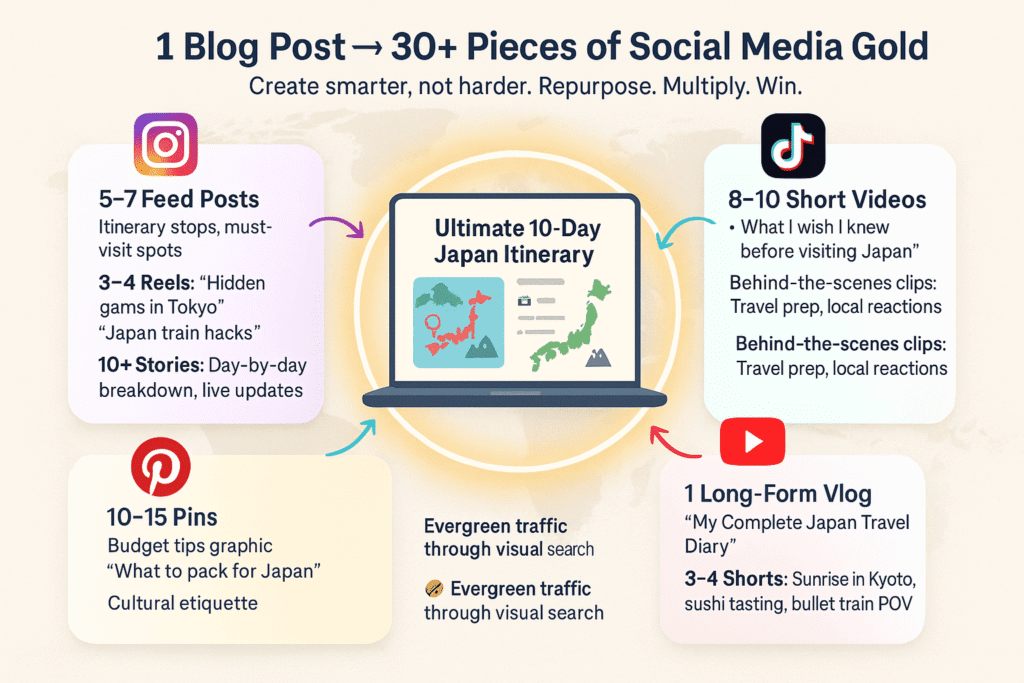
Start with your hero content, usually a comprehensive travel blog post about a destination or travel experience. From that single post, you can create:
- Instagram: 5-7 feed posts highlighting different aspects, 10+ story highlights, 3-4 Reels focusing on specific tips or moments
- TikTok: 8-10 short videos covering individual points from your travel blog post, behind-the-scenes content from your research process
- Pinterest: 10-15 pins with different angles: budget tips, itinerary highlights, packing suggestions, cultural insights
- YouTube: One comprehensive long-form video covering the full experience, plus 3-4 Shorts highlighting key moments
Adaptation, Not Duplication
Each platform has different content consumption patterns. Instagram users might want quick, visual inspiration. TikTok users prefer entertaining, snackable content. Pinterest users are planning future trips and need detailed, practical information.
The same Bali temple visit becomes a serene Instagram carousel, an energetic TikTok about temple etiquette, and a detailed Pinterest guide covering visiting hours, dress codes, and photography restrictions.
Want to scale your content across all platforms?
Read our in-depth social media marketing guide and discover step-by-step strategies to build a strong social media presence.
AI Tools Travel Bloggers Can Use Right Now
Artificial intelligence isn’t replacing travel bloggers; it’s making the smart ones exponentially more productive. Here are the AI tools that are useful for travel blogs and content creators.
Content Creation AI Tools
ChatGPT for Caption Writing
Input your photo and key details, then ask ChatGPT to write engaging captions in your voice. It’s particularly good at generating question prompts and call-to-actions that drive engagement.
Copy.ai for Headlines
Struggling with travel blog post titles or video hooks? Copy.ai can generate dozens of variations based on your core topic. It’s especially useful for creating platform-specific headlines.
Lumen5 for Video Creation
Transform favorite travel blogs into engaging videos automatically. Upload your travel blog content, and Lumen5 creates video scenes with relevant stock footage, music, and text overlays.
Visual Content AI
Canva’s Magic Design
Input your content topic, and Canva’s AI suggests complete design layouts for social posts, stories, and Pinterest pins. It’s like having a designer who works instantly.
Pictory for Video Editing
Turn written content into professional-looking videos without traditional video editing skills. Particularly useful for creating educational travel content from your travel blog posts.
AI Tool Comparison Table
| Tool | Best For | Free Tier | Paid Plans | Time Saved Weekly |
| ChatGPT | Caption writing, idea generation | Limited | $20/month | 5–8 hours |
| Copy.ai | Headlines, ad copy | 2,000 words | $49/month | 2–3 hours |
| Lumen5 | Blog-to-video conversion | 3 videos | $29/month | 4–6 hours |
| Canva AI | Social media graphics | Limited | $15/month | 3–4 hours |
| Pictory | Script-to-video | 3 videos | $23/month | 6–8 hours |
| RecurPost AI | Social media post generation, recycling | Limited (with scheduling) | $25/month | 4–7 hours |
Analytics & Growth Tracking For Travel Bloggers
Data doesn’t lie, but it can confuse you if you’re tracking the wrong metrics. Most travel bloggers either ignore analytics completely or get overwhelmed by vanity metrics that don’t indicate business growth.
Metrics That Matter
Forget follower count, it’s the least important metric for measuring real success. Focus on metrics that indicate genuine audience engagement and business potential.
Engagement Quality Over Quantity
Save Rate:
The percentage of people who save your content indicates it’s valuable enough to reference later. High save rates suggest your content provides lasting value, not just momentary entertainment.
Comment Sentiment
Ten thoughtful comments asking follow-up questions are more valuable than 100 emoji reactions. Quality comments indicate genuine interest and potential customer relationships.
Story Completion Rate
On Instagram, track how many people watch your stories from beginning to end. High completion rates suggest your helpful content keeps people engaged throughout the entire narrative.
Click-Through Rate
Whether it’s link clicks to your blog, swipe-ups to affiliate products, or taps to your website, tracking actual traffic generation reveals content that drives business results.
Platform-Specific Success Indicators For Travel Blog
Each platform defines success differently, so your tracking approach needs to reflect those differences.
Instagram Success Metrics:
- Reach growth month-over-month
- Story-to-feed conversion (people who see your story then visit your feed)
- Profile visits from content
- Website clicks from bio
TikTok Success Metrics:
- Average watch time per video
- Profile visits from videos
- Follower conversion rate (views to followers)
- Cross-platform traffic (TikTok to Instagram/blog)
Pinterest Success Metrics:
- Monthly impressions growth
- Click-through rate to the travel blog
- Save-to-click ratio
- Seasonal performance patterns
Growth Hacks Based on Data
The most successful travel bloggers use data to identify what’s working and double down on those strategies. Here are growth tactics based on real performance patterns.
Content Timing Optimization
Most creators post when it’s convenient for them, not when their audience is most active. Analyze your insights to find your audience’s peak activity hours, then schedule content for maximum visibility.
Your audience’s active hours might not match general “best times to post” advice. If your followers are primarily based in Asia but you’re posting at US peak hours, you’re missing your window for maximum engagement.
Hashtag Performance Analysis
Track which hashtags drive engagement versus just adding clutter to your posts. Many travel bloggers use the same 30 hashtags on every post without analyzing which ones generate results.
Create hashtag sets for different content types (destination posts, travel tips, behind-the-scenes content) and rotate them based on performance data. Hashtags that generate profile visits and followers are worth keeping; hashtags that add reach but no engagement can be replaced.
Content Format Testing
Your audience might prefer carousel posts over single images, or short-form videos over long captions. Test different content formats systematically and track performance differences.
Run A/B tests on similar content: post the same travel tip as both a carousel and a single image, then compare engagement rates, saves, and website clicks. Let data guide your content format decisions.
Interactive Case Study Builder Template
Instead of just reading about analytics, you need a system for tracking your own performance patterns and growth strategies.
Monthly Performance Review Framework
Content Performance Analysis:
- Top 5 performing posts by engagement rate
- Top 5 performing posts by reach
- Top 5 performing posts by website clicks
- Bottom 5 performing posts (what to avoid)
Audience Growth Analysis:
- New followers gained
- Follower loss (and potential reasons)
- Audience demographic shifts
- Geographic audience changes
Business Impact Analysis:
- Website traffic from social media
- Email subscribers gained from social content
- Affiliate clicks and conversions
- Brand inquiry volume and quality
Weekly Optimization Checklist
Every Sunday, spend 30 minutes reviewing the previous week’s performance:
- Which posts exceeded average performance? What made them different?
- Which posts underperformed? What can you learn from them?
- What audience feedback or questions can inspire next week’s content?
- Are you maintaining your content mix ratios (educational/inspirational/behind-the-scenes)?
This weekly review process helps you adapt quickly rather than waiting months to notice performance patterns.
Real Case Studies: Successful Travel Bloggers Who Nailed It
Learning from successful travel blog creators provides concrete examples of strategies that work in practice. These aren’t theoretical approaches; they’re real tactics used by creators who’ve built sustainable, profitable travel brands.
Kirsten Alana: From General Photographer to Travel Content Powerhouse
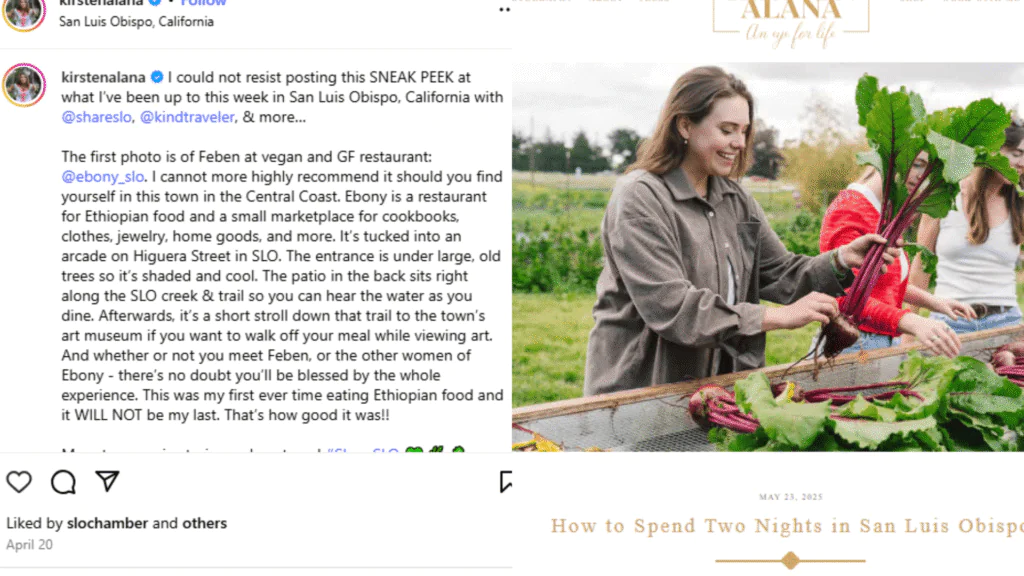
@KirstenAlana transformed her photography career into a thriving travel content business, growing to 185K Instagram followers and securing partnerships with premium publications including Elle, HuffPost, Mashable, Harper’s Bazaar, and Daily Mail.
The Foundation: Professional Skills Meet Strategic Positioning
Background & Transition
Kirsten’s journey began with formal training in television journalism before establishing herself in portrait photography. In 2010, she strategically shifted to travel-focused content creation, launching a travel blog and leveraging her technical photography expertise to stand out in an increasingly saturated market.
The “Conscious Storytelling” Differentiator
Rather than producing typical travel snapshots, Kirsten positioned herself as a “conscious storyteller,” creating meaningful narratives about places and cultures. This approach resonates with modern travelers seeking authentic, responsible travel experiences and sets her apart from surface-level travel content.
Content Strategy: Quality Over Quantity
Professional Excellence as Baseline:
Kirsten’s formal photography background provides technical excellence that elevates her content above amateur travel photography. Her travel blog showcases how professional skills create immediate visual impact and credibility, making each destination come alive through her lens.
Strategic Geographic Focus
Instead of attempting to cover every destination, Kirsten built deep expertise around specific regions while maintaining a balance of local Los Angeles content and international adventures. This approach keeps content fresh while establishing authority in chosen markets.
Authentic Narrative Integration
Each post combines high-quality visuals with meaningful storytelling, creating content that educates and inspires rather than simply showcasing destinations.
Business Model: Multiple Revenue Streams
Premium Brand Partnerships:
Kirsten’s client roster includes established media companies across multiple continents, demonstrating how consistent quality content attracts high-value partnerships with publications that have editorial standards.
Direct Client Services
She offers professional services as a “travel photographer and conscious storyteller for hire,” creating a direct monetization channel alongside social media income and brand partnerships.
Sustainable Growth Model:
Her business operates on multiple revenue streams: direct client work, brand partnerships, social media monetization, and publication collaborations, reducing dependency on any single income source.
Performance Metrics & Market Position
Audience Growth
With 185K followers built over 10+ years, Kirsten’s growth significantly exceeds Instagram’s average monthly growth rate of 0.77-1.2%. Her sustained growth despite being an established account indicates a strong content-market fit.
Engagement Quality
While specific engagement rates aren’t publicly available, her continued partnerships with premium publications suggest audience engagement well above travel accounts’ typical 1-3% rates. Her professional content quality likely drives higher engagement metrics.
Industry Recognition
Consistent work with major publications validates both content quality and audience value, positioning her as a trusted creator in the travel content space.
Natasha Danielle: Solo Female Travel TikTok Success Story
@theworldpursuit built a massive TikTok following of 660.8K with 28.2M likes, positioning herself as a solo female travel creator with the ambitious goal of visiting 100 countries.
The Strategy
Solo Female Travel Niche
Natasha carved out the specific solo female travel market, addressing safety concerns, practical tips, and empowerment messaging that resonates with women wanting to travel independently
Adventure-Focused Content
Her bio emphasizes active travel—”I travel, hike, snowboard, & sleep-that’s it”—positioning her as an adventure traveler rather than a luxury travel influencer, appealing to budget-conscious, active audiences.
Practical Value
Content includes destination-specific tips like “3 THINGS TO KNOW BEFORE GOING TO | GREECE,” providing actionable advice that drives engagement and saves for future reference.
Platform Mastery
TikTok-First Approach
Unlike many travel creators who start on Instagram, Natasha built her primary audience on TikTok, leveraging the platform’s algorithm to reach wider audiences through travel and adventure hashtags.
Cross-Platform Presence
Maintains Instagram presence while keeping TikTok as the primary growth engine, maximizing reach across platforms.
Key Insight
Natasha’s success demonstrates that solo female travel content thrives on TikTok when combined with practical advice, adventure focus, and authentic storytelling that empowers other women to travel independently.
From Posting to Profiting: Monetization for Travel Creators
Creating engaging content is only half the equation; turning that content into sustainable income requires strategic thinking about monetization. The most successful travel creators diversify their income streams while maintaining authentic relationships with their audiences.
Collaborations & Brand Outreach That Actually Works
Most travel bloggers approach brand partnerships backwards. They wait for brands to discover them, then accept whatever terms are offered. Successful creators actively cultivate brand relationships and position themselves as valuable marketing partners.
Building Your Brand Partnership Portfolio
Start with Local Businesses
Before pitching international hotel chains, build your collaboration portfolio with local businesses in your area. Partner with nearby hotels, restaurants, or experience providers to create content that demonstrates your value proposition.
Document Everything
Create case studies for every brand collaboration, showing reach, engagement, website traffic generated, and audience feedback. This documentation becomes powerful evidence when pitching larger brands.
Develop Rate Cards
Know your worth and communicate it. Base your rates on engagement metrics, audience demographics, and content creation scope, not just follower count.
The Outreach Email That Gets Responses
Subject lines matter enormously in brand outreach. “Collaboration Opportunity” gets ignored. “How [Your Brand] Could Reach 50K Travel Planners” gets opened.
Your outreach should include:
- Specific audience demographics and engagement metrics
- Examples of similar brand collaborations with results
- Content creation timeline and deliverables
- Professional media kit with recent performance data
Building Long-Term Brand Relationships
One-off sponsored posts generate short-term income. Long-term brand ambassadorships create sustainable revenue streams. Focus on building relationships with brands whose values align with your content philosophy.
The best brand partnerships feel natural to your audience because they represent products or services you genuinely use and recommend. These authentic partnerships generate better results for brands and higher trust levels with your audience.
Affiliate Marketing for Travel Bloggers
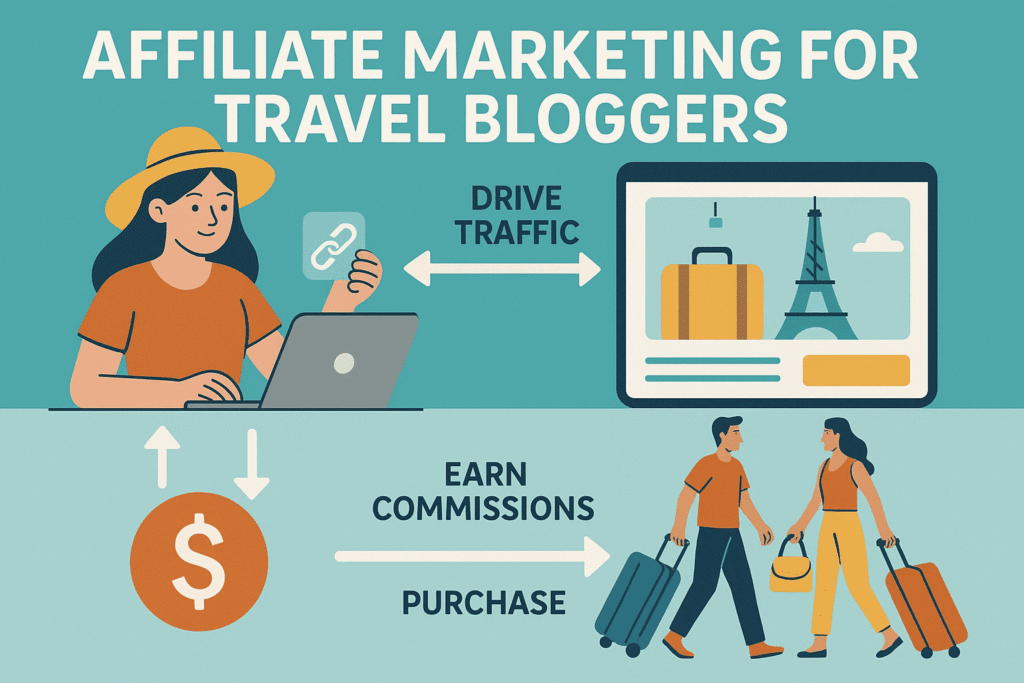
Affiliate marketing can generate significant passive income for travel bloggers, but success requires strategic product selection and authentic promotion tactics.
High-Converting Travel Affiliate Categories
Travel Gear
Luggage, cameras, travel accessories, and outdoor equipment generate consistent affiliate commissions because they’re necessary purchases for active travelers.
Accommodation Booking
Booking.com, Airbnb, and hotel booking platforms offer competitive commission rates and high conversion potential since your audience actively books accommodations.
Travel Insurance
High-ticket affiliate commissions combined with genuine necessity make travel insurance a profitable affiliate category.
Experience Bookings
Tours, activities, and unique experiences through platforms like GetYourGuide or Viator convert well when promoted within destination-specific content.
Affiliate Travel Promotion Strategies That Convert
Problem-Solution Content
Address specific travel challenges, then recommend affiliate products as solutions. “Protecting Electronics While Backpacking” naturally leads to affiliate links for protective gear.
Honest Product Reviews
Detailed reviews that include both pros and cons generate higher trust and conversion rates than purely promotional content. Your audience values honest opinions over sales pitches.
Comparison Content
“Best Travel Cameras Under $500” or “Budget vs. Luxury Luggage” posts allow you to include multiple affiliate links while providing genuine value to readers.
Lead Magnets, Travel Products & Digital Offers
Digital products and lead magnets create income streams that aren’t dependent on brand partnerships or affiliate commissions. They also establish you as an expert authority in travel planning.
Lead Magnets That Build Your Email List
Destination-Specific Packing Lists
Create detailed packing checklists for different types of trips (Southeast Asia backpacking, European winter travel, tropical beach vacations) to attract subscribers planning specific journeys.
Budget Travelers Worksheets
Downloadable budget planning templates appeal to cost-conscious travelers and provide genuine utility while building your email list.
Travel Planning Calendars
Month-by-month guides showing the best times to visit popular destinations based on weather, crowds, and pricing.
Digital Travel Products That Sell
Comprehensive Travel Guides
Detailed destination guides priced between $15-40 compete with traditional guidebooks while offering more current, personalized advice.
Online Travel Planning Courses
Step-by-step courses that teach travel planning skills often generate higher revenue per customer than physical products, while allowing you to monetize your expertise.
Custom Itinerary Services
Personalized trip planning services often command premium rates, ranging from $200 to $500 or more per itinerary, by delivering high value to busy travelers who don’t have time to plan themselves.
Pricing Strategies That Work In Travel Blogging
Start with lower-priced products ($15-30) to establish customer relationships, then introduce higher-priced offerings to your existing customer base. Bundle related products (destination guide + packing list + budget worksheet) to increase average order value.
Test different price points using limited-time promotions to find your audience’s price sensitivity. Many travel bloggers undervalue their expertise and price products too low, leaving money on the table.
Travel Content That Scales: Workflow + Strategy
Creating content consistently while managing business growth requires systems that scale with your success. The difference between hobbyist bloggers and a successful travel blog often comes down to workflow efficiency and strategic planning that supports long-term creative output.
The Content Creation Assembly Line
Successful travel creators don’t approach content creation as a daily scramble. They operate like efficient media companies with clear processes, defined roles (even if they’re filling all roles themselves), and systems that maximize output while maintaining quality.
Batch Content Creation Process
Planning Phase (Monthly)
Dedicate one day each month to content planning. Review upcoming travel plans, seasonal trends, and audience requests to create a comprehensive content calendar.
Research Phase (Weekly)
Spend 2-3 hours each week researching trending topics, competitor content, and audience interests. This research informs your content creation and keeps you ahead of trends.
Creation Phase (Bi-weekly)
Block out 6-8 hour periods for intensive content creation. Shoot multiple videos, write several nice travel blog posts, and design graphics in concentrated bursts rather than spreading creation across every day.
Editing Phase (Weekly)
Designate specific days for editing and post-production. Batch editing similar content types (all videos on Tuesday, all graphics on Wednesday) increases efficiency and maintains consistency.
Content Documentation System For Travelling
Shot Lists
Before any trip or photo session, create detailed shot lists covering the different content types you need. Include wide shots, detail shots, behind-the-scenes content, and specific angles for different platforms.
Content Bank Organization
Develop a filing system for your content assets. Organize by destination, content type, and season so you can quickly locate specific content when needed.
Caption and Copy Database
Save successful captions, email subject lines, and promotional copy in a searchable database. This approach prevents you from starting from scratch each time and ensures consistency in your brand voice.
90 Days to Growth: Challenge for Travel Creators
Most travel bloggers approach growth randomly, posting when they feel like it, trying new strategies sporadically, and getting discouraged when they don’t see immediate results. This structured 90-day challenge provides a clear roadmap for consistent growth.
Days 1-30: Foundation Building
Week 1: Audit and Optimize
- Analyze your current content performance across all platforms
- Optimize all social media profiles with consistent branding and clear value propositions
- Create or update your content calendar template
- Set up analytics tracking for key metrics
Week 2: Content Systems
- Establish your content creation workflow
- Create templates for different content types (Instagram posts, TikTok videos, travel blog posts)
- Set up content scheduling tools
- Build your caption and hashtag databases
Week 3: Audience Research
- Survey your existing audience about their interests and challenges
- Research competitor content to identify gaps you can fill
- Define your unique value proposition as a travel creator
- Create audience personas for your ideal followers
Week 4: Content Creation Sprint
- Batch create 30 days of content using your new systems
- Film videos, write captions, design graphics
- Schedule the first month of content across all platforms
- Create lead magnets for email list building
Days 31-60: Engagement and Growth
Weeks 5-6: Community Building
- Respond to every comment within 2 hours during peak hours
- Engage with other creators in your niche daily
- Join travel-related Facebook groups and contribute valuable insights
- Start building relationships with potential collaboration partners
Weeks 7-8: Content Optimization
- Analyze performance data from your first month
- Identify top-performing content types and create more similar content
- Test different posting times and content formats
- Begin A/B testing captions, hashtags, and visual styles
Days 61-90: Monetization and Scaling
Weeks 9-10: Revenue Generation
- Launch your first lead magnet and email sequence
- Reach out to 5 potential brand partners weekly
- Implement affiliate marketing strategies
- Create your first digital product or service offering
Weeks 11-12: Systems Refinement
- Streamline your content creation process based on what you’ve learned
- Automate repetitive tasks wherever possible
- Scale successful content formats and strategies
- Plan your next 90-day growth phase
Weekly Tracking Metrics
Growth Metrics:
- New followers across all platforms
- Email list growth
- Website traffic from social media
- Brand partnership inquiries
Engagement Metrics:
- Average engagement rate per platform
- Comments-to-likes ratio
- Story completion rates
- Save rates for educational content
Revenue Metrics:
- Affiliate commission generated
- Digital product sales
- Brand partnership income
- Email list monetization
2025 Trends: What’s Next for Travel Bloggers on Social
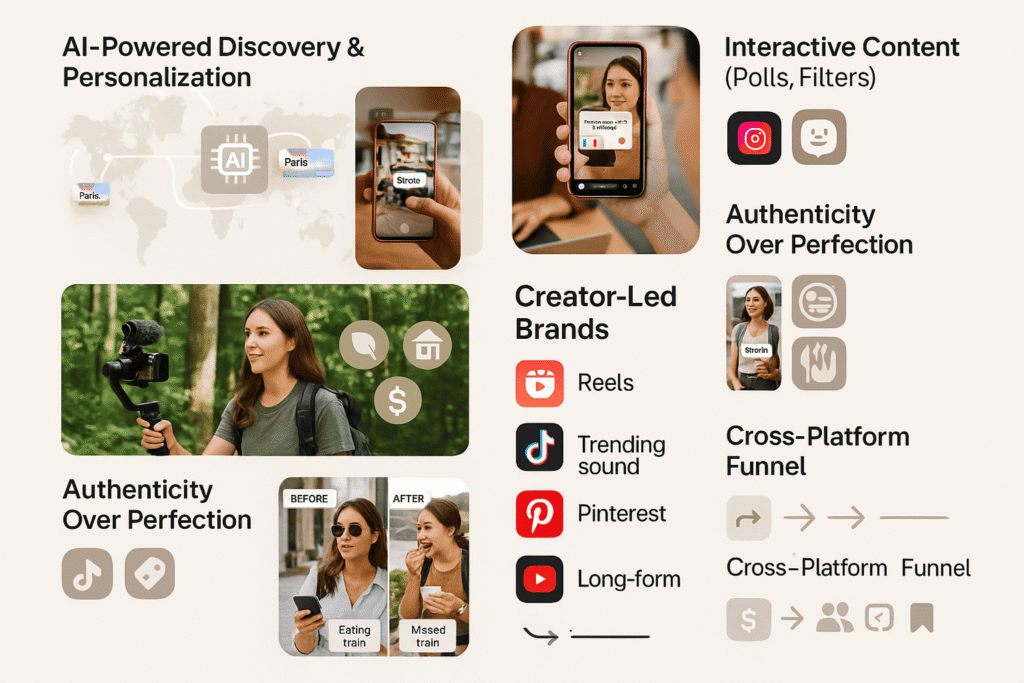
The travel content landscape evolves rapidly, and staying ahead of trends can mean the difference between growth and stagnation. These emerging trends represent opportunities for forward-thinking travel creators.
AI-Powered Discovery and Personalization
Artificial intelligence is transforming how travelers discover destinations and plan trips. Social media platforms are implementing AI-driven content discovery that surfaces highly personalized travel recommendations based on user behavior, preferences, and past interactions.
What This Means for Travel Creators
Instead of creating broad “Best of Europe” content, successful creators are developing ultra-specific content for niche audiences. “Content like ‘Solo Female Travel in Romania for Photography Enthusiasts’ outperforms more generic Europe-focused posts.
Interactive Content Integration
Platforms are prioritizing interactive content that allows users to engage beyond passive consumption. Poll stickers, question prompts, and AR filters that let followers virtually experience destinations are becoming essential.
Predictive Content Planning
AI tools can now analyze travel booking patterns and search trends to predict which destinations will be popular 6-12 months in advance. Smart creators use this data to create content ahead of demand curves.
Sustainability-Focused Storytelling
Environmental consciousness is shifting from a nice-to-have to a necessity in travel content. Younger travelers, in particular, expect travel creators to address topics like sustainability, overtourism, and responsible travel practices.
Sustainable Travel Content That Resonates
Overtourism Solutions
Instead of promoting overcrowded destinations, successful creators highlight alternative locations that offer similar experiences with less environmental impact.
Local Economic Impact
Content that showcases how travel dollars support local communities, small businesses, and conservation efforts resonates with conscious travelers.
Carbon Footprint Awareness
Creators are incorporating carbon offset information, slow travel principles, and transportation alternatives into their content naturally rather than preachily.
Authenticity Over Perfection
The Instagram-perfect travel aesthetic is giving way to more authentic, realistic travel content. Travelers want to see real experiences, including challenges, mistakes, and unglamorous moments.
Creator-Led Travel Brands
Travel bloggers are evolving beyond content creation into full-scale travel companies. The most successful creators are launching their own travel products, services, and experiences.
The Creator-to-Entrepreneur Pipeline
Group Travel Experiences
Travel creators are organizing and leading group trips, combining their expertise with direct monetization opportunities.
Travel Planning Services
Creators are packaging their destination knowledge into consulting services, custom itinerary creation, and travel planning courses.
Affiliate Program Creation
Some creators are launching their affiliate programs, allowing other creators to promote their products and services.
Brand Partnerships Evolution
The creator-brand relationship is becoming more sophisticated. Instead of one-off sponsored posts, brands are seeking long-term partnerships that include product development, exclusive content series, and co-created experiences.
Multi-Platform Content Strategy
The most successful travel creators are developing platform-specific content strategies rather than simply cross-posting the same content everywhere.
Platform-Native Content Approach
- Instagram: Focusing on visual storytelling with a strong emphasis on Stories and Reels for real-time engagement.
- TikTok: Educational content that entertains, with emphasis on trending sounds and challenges adapted for travel.
- Pinterest: SEO-optimized pins designed for discovery during travel planning phases.
- YouTube: Long-form educational content that establishes expertise and authority in specific travel niches.
Cross-Platform Funnel Strategy
Smart creators use each platform as part of a larger funnel system. TikTok discovery leads to Instagram followers, which drive blog traffic, which converts to email subscribers, who eventually become customers.
Micro-Influencer Monetization
Brands are shifting budgets toward micro-influencers (10K-100K followers) who demonstrate higher engagement rates and more authentic audience relationships than mega-influencers.
What This Means for Growing Creators
- Quality Over Quantity: Engagement rate and audience authenticity matter more than follower count for monetization opportunities.
- Niche Specialization: Creators who specialize in specific travel niches (solo female travel, budget backpacking, luxury family travel) are more attractive to brands than generalist accounts.
- Long-Term Partnerships: Brands prefer ongoing relationships with creators who can demonstrate consistent audience engagement and authentic brand alignment.
Freebies & Downloads Hub For Travel Bloggers
Here’s your complete toolkit for implementing everything we’ve covered in this guide. These resources are designed to save you hours of planning and help you execute the strategies immediately.
Content Calendar Template
Monthly Planning Template: Includes sections for seasonal trends, content themes, platform-specific posting schedules, and brand partnership tracking.
Weekly Content Planner: Day-by-day planning grid with space for captions, hashtags, and cross-platform adaptation notes.
Travel Content Shot List: A Comprehensive checklist covering all content types you should capture during trips, organized by platform requirements.
Download– Free Instagram content calendar to plan and schedule
Case Study Builder Worksheet
Performance Tracking Sheet: Monthly and weekly metrics tracking for all platforms, including engagement rates, reach, website traffic, and monetization metrics.
Content Analysis Framework: Template for analyzing your top and bottom-performing content to identify patterns and optimization opportunities.
Growth Goal Setting: Quarterly goal-setting worksheet with specific, measurable targets for followers, engagement, and revenue.
Hook & Caption Vault
50 Proven Hook Templates: Tested opening lines for different content types (educational, inspirational, behind-the-scenes, promotional).
Caption Formulas: Plug-and-play caption structures for different platforms and content goals.
Call-to-Action Bank: Engagement-driving questions and prompts organized by platform and content type.
AI Tools Implementation Guide For Travel Bloggers
- Tool Setup Instructions: Step-by-step guides for implementing ChatGPT, Copy.ai, Canva AI, and other tools in your workflow.
- Prompt Templates: Proven prompts for generating captions, headlines, and content ideas using AI tools.
- Workflow Integration: How to incorporate AI tools into your existing content creation process without disrupting your brand voice.
90-Day Challenge Calendar
- Printable Calendar: Day-by-day action items for the complete 90-day growth challenge.
- Weekly Checklist: Specific tasks and milestones for each week of the challenge.
- Progress Tracking: Metrics to monitor and celebrate throughout your 90-day journey.
Final Thoughts: Your Beaten Path to Travel Content Success
We’ve covered a lot of ground here, from platform-specific strategies to monetization tactics to future trends. But here’s the thing: information without action is just entertainment. The difference between creators who succeed and those who stay stuck is implementation.
You don’t need to master everything at once. Pick one platform, implement one strategy, and commit to consistency for 90 days. Then expand from there. Whether you’re starting a new travel blog or scaling an existing one, consistent effort beats perfection every time.
The travel content space is more competitive than ever, but it’s also more opportunity-rich. Brands are spending more on creator partnerships, audiences are hungry for authentic travel insights, and the tools for creating professional content are more accessible than ever. A travel blog today can evolve into a powerful platform for storytelling, influence, and income.
Your unique perspective, travel experiences, and personality are your biggest assets. No one else can tell your stories or share your insights in quite the same way. That’s not just inspiration, it’s your competitive advantage.
The creators who thrive in 2025 and beyond will be those who master the fundamentals we’ve covered here: consistent content creation, authentic audience engagement, strategic platform use, and diversified monetization. If you’re serious about building a successful travel blog, now is the time to act, adapt, and grow.
Frequently Asked Questions
1. What’s a good budget for social media marketing?
It depends on your goals and scale. Many travel bloggers start with free tools (like Canva Free, CapCut, Buffer Free) and spend ₹1,500–₹5,000/month when they upgrade to premium tools like Canva Pro or scheduling platforms once traction begins.
2. How do I measure actual success, not just likes?
Go beyond vanity metrics: track saves, comments, story completion rates, click-throughs to your blog, and affiliate income. These show real engagement and ROI.
3. Can I legally reuse other people’s travel images or videos?
No, always respect copyright. Use your own visuals or royalty‑free options from Unsplash or Canva. Better yet, create unique content to protect your brand and avoid legal trouble.
4. How often should I repurpose a travel post across platforms?
Aim for 1–2 repurposings per platform from one blog post: e.g., 3 Reels + 5 Pins + 1 YouTube Short + 2 TikToks. Adapt each to the platform style, don’t just copy and paste.
5. Is influencer marketing worth trying as a travel blogger?
Yes, when done authentically. Travel influencers often earn via brand collabs and affiliate links. Start small: pitch local tourism offices or gear brands once you have consistent engagement.
6. How do I know which hashtags drive real traffic?
Run hashtag sets by content type (e.g., budget tips, cultural posts). Track which sets yield more profile visits, website clicks, and saves, then refine monthly.
7. Do I need to post every day?
No, consistency and strategy matter more than frequency. Use a content calendar: theme each month, rotate weekly topics, and post platform-specific content a few times per week.

Fenil Patel is a content writer specializing in social media marketing. He creates engaging, results-driven content that helps brands grow online, connect with audiences, and boost digital visibility. With a sharp eye for trends and strategy, he turns ideas into content that performs. Fenil is passionate about helping businesses stand out in the fast-paced world of digital marketing.
